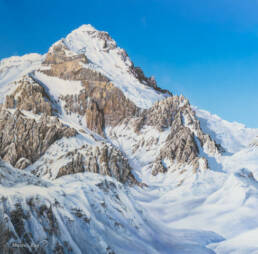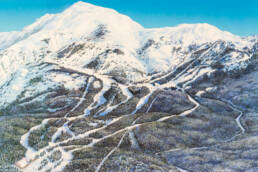Murray Hay helped pioneer the art of the ski map.
What distance would you go for your art? Graffiti artists risk death on the Brooklyn Bridge. Henri Matisse used poison paint to achieve vibrance in The Red Studio. Ernest Hemingway survived two plane crashes in two days while on safari in Africa. He emerged from the jungle carrying a bunch of bananas and a bottle of gin. “My luck,” he told Time, “she is running very good.”
Murray Hay’s risks were perhaps more measured and lesser known. In the mid-20th century, when skiing was hip, he’d strap himself to a harness to hang from an open door of an aircraft high above glaciers and peaks. Holding a Pentax loaded with film, Hay snapped overviews of mountainous terrain. Lake Louise. Alyeska. Sun Valley. Sunshine. Blackcomb. The images served as foundation for his art: intricate, accurate, exquisite hand-painted trail maps. To this day, Murray Hay’s pluck still helps countless skiers pick their way down strange mountains, whether they know it or not.
Murray Hay’s intro to skiing came in the mid-1970s by way of Banff. Lake Louise owner Charlie Locke reached out to the Calgary-based commercial artist on a whim. Hey Hay! one imagines, You’re a painter. Can you draw me a trail map?
The answer was no.
“I had no idea,” Hay told the Calgary Sun in 1991. At age 55, “I didn’t know what the hell skiing was.” He learned quickly enough. Signing on first with Lake Louise and later with ski resorts in British Columbia, Idaho, Alaska, and Japan, he helped pioneer skiing’s map-making process in the days before computers.


In a career that stretched three decades from the 1970s to the 1990s, Murray Hay joins Hal Shelton and James Niehues as three of North America’s most prolific resort map illustrators.
Today, Murray Hay’s daughters, Allison and Lynda, describe their father’s process as painstaking, time-consuming, and meticulous. For each project the artist spent hours on the edges of his comfort zone, strapped into a harness and leaning from the open door of a helicopter or a Cessna. He flew across ragged landscapes for hours in a grid pattern, snapping photographs of a ski area’s slopes, trees, lodges, and topography. Back at his drawing board — a basement studio at home in Calgary — the artist pieced the images together in a panoramic view. Using old-school tools (pencils, rice paper), Hay traced trails, gullies, lift lines, and trees. Resort staff made changes to those pencil sketches, adding a band of rock here, or a dip in elevation there. “He was always taking them back and forth for ski-area approval,” Allison says. “For them, he’d literally move mountains!”
The artist spent up to three months transforming his sketches into one enormous painting: acrylic on canvas rendered with detail and care. Allison describes an artist at work “with a teeny, tiny brush getting the shapes of the trees or the exact point the sun was shining. He’d paint moguls so you actually felt as though you were skiing on the map.”
But sometimes Hay got bored. “His work would take hours and hours and hours. We’d hear him giggling in the basement and he’d say, Come here and look! He’d painted ski crashes — or little tiny fights — into the crowd scenes in a Where’s Waldo style. They were hard to find unless you knew where to look.” Study a Murray Hay hard. You may see hidden tracks in the snow, dueling skiers in a lift line, or footsteps trailing down a mountain slope.
In the final stages of each piece, Hay added trail names, chairlift routes, and legends to the paintings, then wrote his signature obscurely in the upper right corner. To this day, skiers peer at trail maps and say, Is that a Murray Hay?
“Murray Hay’s pluck still helps countless skiers pick their way down strange mountains, whether they know it or not.”
Murray Hay’s daughter Lynda describes her father as humble, hardworking, and a “first flake skier.” Inspired at age 55 to learn to ski, she says he morphed into a “mature ski bum”, clomping around the house at the first sign of snow, getting familiar with new ski boots.
Despite his age, Hay learned fast… and skied fast, beating everyone else down the slopes he’d come to know by painting them in detail.
Hay died in Calgary in 2015 at the age of 84. With his original works replaced on the sides of ski runs by digital copies — many based on Hay’s original drawings — some are resurrected now in Banff’s Willock & Sax Gallery and at the Whyte Museum of the Canadian Rockies. But the artist’s reputation for detail lives on in many a ski household. “I can’t count how many times people tell me they were lost at a ski area but found their way because they had one of my father’s ski maps,” says Allison. No worries, they say, I had a Murray Hay in my pocket.


